 |
I wanted to buy some presents for my family so after our evening meal we went to the local market. I felt very conspicuous as I was by the looks of it the only westerner there. The market was huge, an amazing and atmospheric nightime labrynth of dark alleyways and stalls selling a huge range of goods, such as spices, fruit, meat, silks, clothes of all kinds and so on. There were even places where you could get shoes or furniture made as well as bicycles repaired. Brahim knew many of the stallholders so he got me a good price on my presents and we joined one of his friends, who owned a general store, in a glass of sweet mint tea at the end of the evening. I never felt threatened although I was being stared at quite a lot. Moroccans are insatiably curious, friendly and generous to a fault judging from my experiences.
 |
| Breakfast at Brahim's house |
 |
| Little Owl |
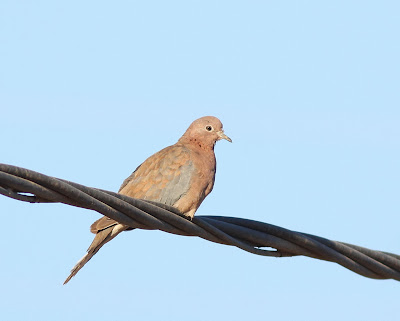 |
| Laughing Dove |
 |
| Fulvous Babblers.This is how they are usually seen if you are lucky |
 |
| Fulvous Babblers unusually out in the open but still never too far from cover |
We saw Desert Larks, Bar tailed Desert Larks, Temminck's Larks and any number of Thekla Larks by the roadside, a quite beautiful adult male Black Redstart sat on a roadsign, Black and White Crowned Wheatears, a Moussier's Redstart, a Long legged Buzzard and two more groups of Fulvous Babblers were also seen as we cruised along. Villages came and went with the customary flat topped, square, pink houses, clustered in a jumble like discarded lego bricks.
We stopped by a dam for our lunch, at midday, sitting in the shade underneath a large tamarisk tree. A simple affair, taken alfresco, of bread, cheese and olives followed with juicy Pomegranates and small sweet Oranges. I found a brilliant red Dragonfly which I later identified as an Orange winged Dropwing, sunning itself by the water. A Kingfisher and a Black Redstart entertained us by the dam outflow.
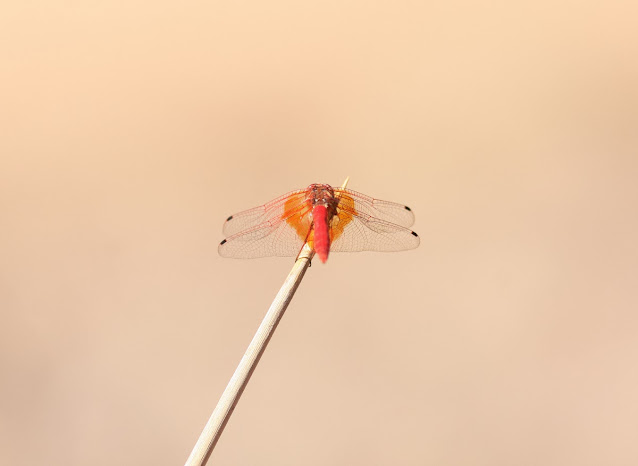 |
| Male Orange winged Dropwing demonstrating exactly why it got it's name |
 |
| Tizi-n-Tinifift Pass |
 |
| Desert Lark. The larks we saw all appeared to be of the darker southern Moroccan race A.deserti payni although there is much geographical variation |
Another long drive ensued in the cold morning air. A little snow had arrived overnight on the highest peaks of the Atlas Mountains but Brahim told me the snows were very late this year. I noted women laden with heavy plastic containers of water walking back on the side of the road to their homes. Not a man in sight or assisting in any way of course. Similar birds to yesterday appeared by the roadside and we did make a couple of stops to try and get some photos of a Hoopoe Lark, some Temmincks Larks and another adult male Black Redstart. Thekla Larks were everywhere by the road
We found ourselves travelling through yet another area of stunning mountain scenery and eventually we came to a town called Taznakhat. The centre as usual was full of Moroccans standing around doing not much of anything apart from talking or drinking tea and sorting their world out.
We made a stop here for our breakfast settling in a cafe that had a couple of mullahs wailing the Koran from a radio behind the counter which made a novel change from the usual blather of popular radio. I have to say at this time in the morning it was an acquired taste and somewhat depressing. I asked Brahim what was going on and he said it was quite usual for such things to be broadcast on Moroccan radio and it can go on for hours. No one in the cafe seemed to take much notice of the incantations and indeed the few Moroccans that were there were mostly talking on mobile phones. I made Brahim laugh when I said maybe the exhortations of the Koran on the radio had prompted them to dial Allah direct.
We left the cafe after the usual pancakes and honey with sweet mint tea. Tea in Morocco is a very ritualised affair and no one drinks the tea without going through the palava of pouring the tea from a tiny metal teapot at great height into a 3 inch high glass. This process is repeated ad nauseam with the tea being poured back into the pot and then poured out again from a similar great height until there is a head of froth on top of the tea. Otman was very particular about this and would only let us drink the tea once he was completely satisfied that all was as it should be with the tea. To top it all a sugar lump the size of an iceberg is produced by the waiter to go in the tea pot to sweeten the tea and leaves of mint. The result is however delicious.
Having left the cafe we had our first and only run in with the Moroccan police at the customary roadblock on the outskirts of town. It was my fault as I was not wearing a seat belt. Although I was in the back of the 4x4 apparently it is the law in Morocco that everyone has to wear a seat belt no matter where they are sat. Unfortunately no one had told me. So we were fined 300 Dirams (about £20.00) by an officious and humourless jobsworth with a peaked hat and gun.
Having left the cafe we had our first and only run in with the Moroccan police at the customary roadblock on the outskirts of town. It was my fault as I was not wearing a seat belt. Although I was in the back of the 4x4 apparently it is the law in Morocco that everyone has to wear a seat belt no matter where they are sat. Unfortunately no one had told me. So we were fined 300 Dirams (about £20.00) by an officious and humourless jobsworth with a peaked hat and gun.
We were now headed for Agadir where we would stay for the next two nights. The scenery slowly changed and we entered a more benign countryside of rolling hills dotted with Argan trees which generally grow to around twenty feet high and are famous for growing nowhere else in the world and producing a highly desirable oil from their nuts. They also seemed to be much favoured by Southern Grey Shrikes as we counted no less than thirteen individually perched atop a tree in a very short period as we drove along.
We made another impromptu stop at another river crossing at the Oued (which means river) Souss. The river was just about running but very much depleted but water equals birds so it was worth a look. Otman drove us down to the side of the river bed and a few Little Egrets flew up from the water's edge and Crag Martins swooped over our heads. Two large raptors appeared at no great height above us, circling to gain height and find a thermal. What on earth were they? Overhead about fifty feet above us we could see a white body with dark streaks. White underwing coverts and then a black band across the underwing and on the carpal coverts. A longish tail with a broad black tip. A pair of adult Bonelli's Eagles! After missing them at Todra Gorge this was a real bonus as we would not have seen them nearly as well at Todra as we did here. After they had disappeared we wandered through the lush green vegetation looking for birds. A Southern Great Grey Shrike did it's best to catch a female Moussier's Redstart and having failed tried it's luck on a male Blackcap. No success there either. A pair of Sardinian Warblers hopped around the shrike mobbing it and five Goldfinches fed on some seeding plants. In the reeds by the water three Green Sandpipers and a couple of Snipe flew up and a Cetti's Warbler, as ever invisible, called loudly whilst Meadow Pipits and White and Grey Wagtails fed on the numerous small flies. A small brown bird flew up out of the reeds but disappeared just as quickly and it took Brahim and myself several attempts at flushing it before it perched briefly in the open and revealed itself to be a Zitting Cisticola. In the end we found three. Last of all, walking back to the 4x4 we found a female Blue Rock Thrush sat, as they do, atop a large boulder watching us. Not bad for an unscheduled stop.
 |
| Male Sardinian Warbler |
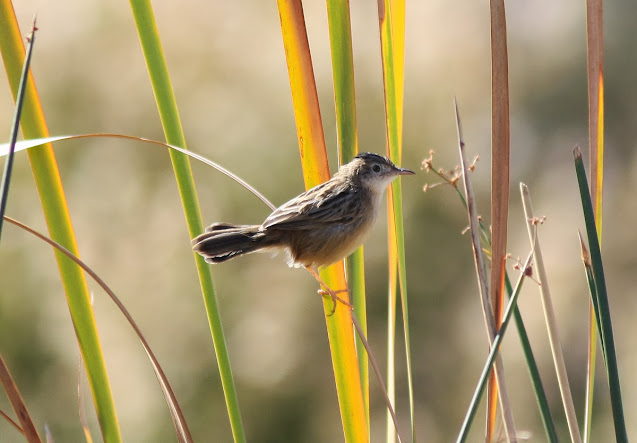 |
| Zitting Cisticola |
 |
| Female Blue Rock Thrush |
 |
| Our impromptu picnic spot. Not a bad place to be! |
Then it was on to Agadir
Brahim had put me in a substitute hotel as apparently the normal one he uses in Agadir was full. I was eagerly anticipating tomorrow as we were going to the Souss-Massa National Park to look for the critically endangered Bald Ibis. On seeing the substitute hotel I just knew it was going to be a disaster. I was duly not disappointed and shown to a dingy room boasting a much trumpeted ensuite bathroom. However there was no soap, no towels, no hot water and the shower did not work. A sign on the bedroom door informed me that the room cost £10.00 per night so maybe I was being a bit too demanding. Tired and dusty after such a long drive I let Brahim know exactly what I felt. It was too late to do anything tonight but the upshot was that I stayed one night here and then was transferred to a very nice hotel for the second night, run by a French lady and her mother with the most wonderful French restaurant attached to it. So in the end we were all friends again.
The next morning I was up very bright and early as I did not want to stay in Hotel Grot one moment longer than necessary. I went to a cafe next door, already with Al Jazeera wide screen news in full swing complete with attendant Moroccans and ordered mint tea and awaited Brahim's arrival. We were away bright and early and heading now for Souss-Massa and hopefully Bald Ibis happiness. We drove south out of Agadir and then turned off the main road and down into a valley irrigated by the Oued Massa and up the other side into the park. It was a huge area ( 338 square kilometres) by the sea and consisting of high sand cliffs and a hinterland of sandy infertile fields. Down in the irrigated valley we found Cattle Egrets, Little Grebes, Common Coots and a couple of European Swallows. We drove on and then up into the park, rising ever higher onto a sandy plateau that stretched for kilometres. Brahim told me the ibis could be anywhere here. My heart sank as it became apparent this was not going to be easy in such a vast area. We drove around and finally left the road and went cross country along sandy, barely visible tracks looking for the ibis. The value of a 4x4 became all too evident and we eventually came to the cliff side overlooking the sea. Yellow legged Gulls and Lesser Black backed Gulls were messing around on the sand and the occasional Common Tern was fishing offshore. We turned inland and came upon a large rough field behind some buildings. I looked and looked again. The field was full of Stone Curlews. I counted them and there were 61 to be precise. We watched them for twenty minutes before a passing Marsh Harrier put them all to flight. Truly an amazing sight. We drove around somewhat aimlessly afterwards finding very little apart from a flock of at least 50 Serins and a few European Stonechats.
I was getting a little frustrated at our lack of ibis action as I knew the park had up to twenty five official wardens.
Why not ask them where the Bald Ibis are, Brahim? It would surely save us a lot of time?'
'Sure we can do that but let's try and find them ourselves first' he replied.
'Aaaagh! Why waste the time doing that?' I felt like saying but decided to remain diplomatic.
We drove into a small tourist village and came to a dusty car park overlooking the sea and a wide sandy beach. I got out of the 4x4 and scanned the beach. Yellow legged and Lesser Black backed Gulls were massed on the beach but just beyond them were five other gulls keeping discreetly to themselves. Audouin's Gulls, four adults and a first year and one of my favourite gulls. They are really so attractive with their crimson bills and black legs. I looked out to sea and two stiff winged seabirds flying south in close formation, alternately showing brown and white and swinging with the wave contours resolved themselves into Balearic Shearwaters. Even better.
There was an official looking Moroccan standing with a French couple in the car park. Could he be one of the park wardens? He took one look at me and my bins, the 4x4 which obviously said 'tourist probably birders' and abandoned the French couple who did not seem too put out and came over pronto to introduce himself. He showed me his official Souss-Massa Guide Permit and asked me if I was looking for the ibis and would I like to utilise his services - or words to that effect in broken English. His name was Mohammed. I needed no second asking after admiring his fluorescent lime green opera glasses!
I engaged him immediately and he was soon on board the 4x4 and we were away. He first directed us however back to the other side of the river where he said there were a lot of good birds to see. There was no point in arguing and Brahim said that now he was with us we were virtually guaranteed to see the Bald Ibis so I relaxed. He took us to the other side of the river bank and there certainly were lots of birds to see. We drew up by the side of the river and the most obvious species was Glossy Ibis with about one hundred and fifty resting on mud banks in the middle of the water surrounded by freshwater turtles and Black winged Stilts mincing about on their impossibly long, coral pink knitting needle like legs. Coots and Little Grebes were swimming around and on another mud bank were both the familiar Great Cormorant and Moroccan Cormorant which has a white face and chest and is now I think recognised as a separate species. I watched the Glossy Ibis and noticed some of them had the rather charming habit of holding one wing vertically open presumably to allow the sun to get to the underwing to flush out parasites. It looked very peculiar and they held this position for long periods of time.
There was an official looking Moroccan standing with a French couple in the car park. Could he be one of the park wardens? He took one look at me and my bins, the 4x4 which obviously said 'tourist probably birders' and abandoned the French couple who did not seem too put out and came over pronto to introduce himself. He showed me his official Souss-Massa Guide Permit and asked me if I was looking for the ibis and would I like to utilise his services - or words to that effect in broken English. His name was Mohammed. I needed no second asking after admiring his fluorescent lime green opera glasses!
I engaged him immediately and he was soon on board the 4x4 and we were away. He first directed us however back to the other side of the river where he said there were a lot of good birds to see. There was no point in arguing and Brahim said that now he was with us we were virtually guaranteed to see the Bald Ibis so I relaxed. He took us to the other side of the river bank and there certainly were lots of birds to see. We drew up by the side of the river and the most obvious species was Glossy Ibis with about one hundred and fifty resting on mud banks in the middle of the water surrounded by freshwater turtles and Black winged Stilts mincing about on their impossibly long, coral pink knitting needle like legs. Coots and Little Grebes were swimming around and on another mud bank were both the familiar Great Cormorant and Moroccan Cormorant which has a white face and chest and is now I think recognised as a separate species. I watched the Glossy Ibis and noticed some of them had the rather charming habit of holding one wing vertically open presumably to allow the sun to get to the underwing to flush out parasites. It looked very peculiar and they held this position for long periods of time.
 |
| Black winged Stilts, Glossy Ibis and turtles |
 |
| Moroccan Cormorant with friends |
We walked on looking for a Black crowned Tchagra but failed to find one although we heard it's distinctive call or song on a number of occasions. Moussier's Redstarts and Laughing Doves were regular and a single Rock Bunting flew up onto one of the walls behind the road. Common ChiffChaffs were everywhere and a male Northern Wheatear was a surprise find resting in the shade of a palm tree surrounded by Common ChiffChaffs. Carrying on along the track by the river a flock of Spotless Starlings were noisily ensconced in a large palm tree and Common Bulbuls were belting out their cheery calls from the larger bushes.We came to another stretch of the river and a flock of Marbled Ducks with a few Northern Shoveler in tow flew up and around in alarm at a passing Marsh Harrier, before settling again. A Eurasian Spoonbill came out from behind some reeds and a small grebe in the middle of the river proved to be a Black necked Grebe.
Time was now getting on and it was getting really hot so I gently suggested maybe we should go and look for the Bald Ibis which was generally agreed to by one and all. On the way back to the vehicle we found a couple of European Stonechats and two Brown throated Martins briefly flew over. I checked the tamarisks on the other side of the river as there was a lot of bird movement in them. Common ChiffChaffs and Sardinian Warblers were two of the species there but then I noticed two sparrows were feeding on the buds of a small tree nearby. I looked and looked again. Unmistakeable - a male Spanish Sparrow presumably with a female that was almost indistinguishable from a female House Sparrow. A really good find
Time was now getting on and it was getting really hot so I gently suggested maybe we should go and look for the Bald Ibis which was generally agreed to by one and all. On the way back to the vehicle we found a couple of European Stonechats and two Brown throated Martins briefly flew over. I checked the tamarisks on the other side of the river as there was a lot of bird movement in them. Common ChiffChaffs and Sardinian Warblers were two of the species there but then I noticed two sparrows were feeding on the buds of a small tree nearby. I looked and looked again. Unmistakeable - a male Spanish Sparrow presumably with a female that was almost indistinguishable from a female House Sparrow. A really good find
 |
| Marbled Ducks and Northern Shoveler |
 |
| Juvenile Long legged Buzzard |
The guide now directed us back to where we had originally met him and then we went on a fairly long drive parallel with the cliff edge, southwards down a wide sandy track that only a 4x4 could achieve. For some time there was nothing to see with just white sandy cliffs and dunes stretching for miles. We drove on with the guide looking into the distance and directing Otman through the sand. Up and down over the dunes we went with even the 4x4 struggling at times. Some hang gliders were flying along the cliff edge in the distance. A little before them I could see a large number of black looking objects moving about on a sand bank to the right of the track we were on. They were however a long way off. I got excited. Perhaps over excited but then what birder wouldn't?
'There they are!' I could not contain myself.
The guide said they were goats. Thankfully for my credibility they were not goats. Brahim confirmed my identification. At last! One of the two most desired species I wanted to see in Morocco was now in view. We drove on and parked some fifty metres from the ibis. They were spread out over the track and sand dunes before us, nonchalantly preening or just sunning themselves. The guide said I could get out and approach them slowly on foot. The rest of them would remain in the 4x4. I approached to within fifteen metres without causing any alarm to the ibis and took an awful lot of pictures. A hang glider came along the cliff and from nowhere another warden on a motorbike appeared and told him in no uncertain terms to clear off, which he did. It's good to see the ibis are well looked after. Apparently my being allowed to approach so closely was a huge favour for which I will be eternally grateful. I was allowed twenty minutes with the ibis before being asked to return to the 4x4.
 |
| Northern Bald Ibis |
In the afternoon we went to the Oued Souss which is another river the other side of Agadir and is next to one of the King of Morocco's Palaces (He has one in every city apparently). We birded the river estuary walking through low scrub right out to where the river joined the sea with huge container vessels anchored out at sea waiting to enter Agadir harbour.
Yellow legged, Lesser Black backed and Audouin's Gulls were around the shore plus a large group of Oystercatchers, one each of Common and Green Sandpiper and the inevitable Sanderlings, their quicksilver movements across the sand betraying their identity from afar, and two immature Slender billed Gulls in amongst a small group of Black headed Gulls was a nice find. Sandwich Terns were fishing in the estuary and one of two Ospreys we saw, flew upriver carrying a huge fish whilst being vigorously mobbed by two Yellow legged Gulls. A group of some eighty four Greater Flamingoes roosted, a swathe of delicate pink, in the middle of the river shallows.
 |
| Greater Flamingoes |
Back at the car park the local Magpies boldly came to check if we had any scraps for them showing off their attractive blue ear patches to good effect.
One of only two Woodpigeons to be seen on the trip flew over. Scarce in Morocco, in direct contrast to Oxfordshire or anywhere else in Britain, Brahim was amazed when I told him how many we get in Britain.
So a glorious and fulfilling day came to it's end and I retired to savour my memories and write up my notes aided by an excellent bottle of French wine, a superb meal served with style and panache and with real roses in a vase on a starched white table cloth.









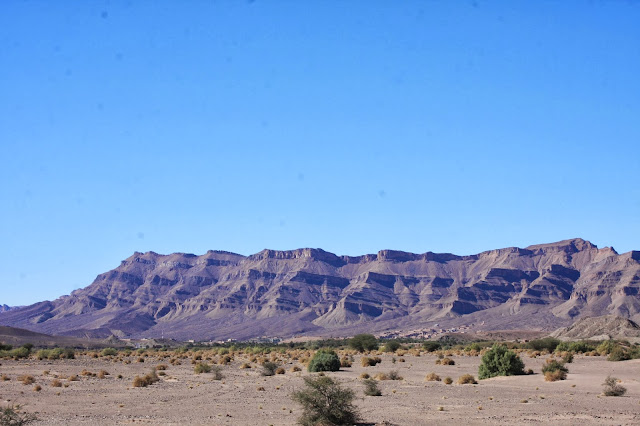






















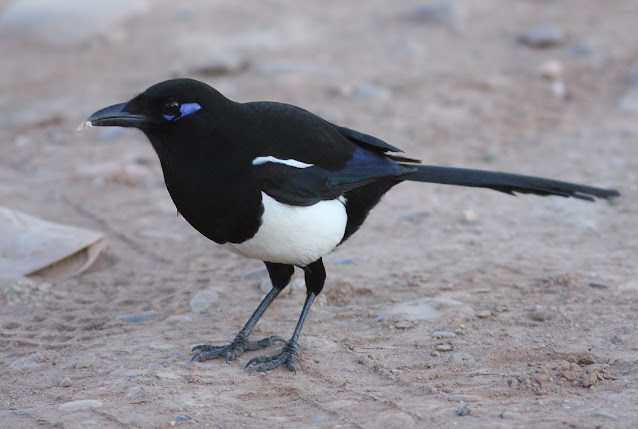

Yep! I'm lost for words - Friends and relations will be giving me plenty of books for Xmas but nothing could compare with this for the sheer feeling of personal involvement and unique style of 'keeping one on ones toes' .and managing to make the sometimes ordinary, interesting.
ReplyDeleteA pre Christmas treat that if you had written it up later would have been my Christmas reading i'm afraid now whatever books I get given for the season of good cheer they are going to be inadequate after your latest offering.
Thank You, Barry.
Many thanks for your kind words Barry. It is much appreciated as always
DeleteSee you at the curry night I hope?
I will be there - should be a hot night in more ways than one and i'm bringing the always most pleasant Pat Wixey with me , he is always good fun and I expect him to contribute to the evening positively.
DeletePat would have loved your latest super piece on the owl as he is the Barn Owl/Hobby man of Oxfordshire.
Looking forward to the curry night.
Barry.